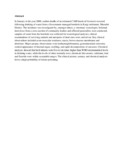| dc.description.abstract | In January in the year 2000, sudden deaths of an estimated 7,000 heads of livestock occurred following drinking of water from a Government managed borehole in Kargi settlement, Marsabit District. The incidence was investigated by, amongst others, a veterinary toxicologist. Informal interviews from a cross-section of community leaders and affected pastoralists were conducted, samples of water from the borehole was collected for toxicological analyses, clinical examinations of surviving animals and autopsies of dead ones were carried out. Key clinical observations included acute muscular weakness, ataxia, brown mucous membranes and abortions. Major autopsy observations were methamoglobinaemia, gastrointestinal corrosion, cooked appearance of internal organ, swelling, and rapid decomposition of carcasses. Chemical analyses showed that both nitrates were five to ten times higher than WHO recommended levels in drinking water, while the levels of other normally toxic chemicals like arsenic, selenium, lead and fluoride were within acceptable ranges. The clinical picture, autopsy and chemical analyses led to a high probability of nitrate poisoning. | en_US |

